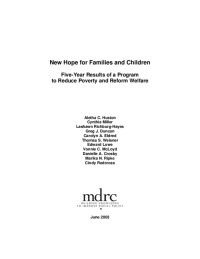New Hope for Families and Children
Five-Year Results of a Program to Reduce Poverty and Reform Welfare
The principle guiding the New Hope Project — a demonstration program that was implemented in two inner-city areas in Milwaukee from 1994 through 1998 — was that anyone who works full time should not be poor. New Hope offered low-income people who were willing to work full time several benefits, each of which was available for three years: an earnings supplement to raise their income above the poverty level; subsidized health insurance; subsidized child care; and, for people who had difficulty finding full-time work, referral to a wage-paying community service job. The program was designed to increase employment and income as well as use of health insurance and licensed child care, and it was hoped that children would be the ultimate beneficiaries of these changes.
A team of researchers at MDRC and the University of Texas at Austin is examining New Hope’s effects in a largescale random assignment study. This interim report from the study focuses on the families and children of the 745 sample members who had at least one child between the ages of 1 and 10 when they entered the study. The new findings draw on administrative records and survey data covering the period up to five years after study entry (Year 5), that is, two years after the program ended. A final report will examine New Hope’s effects after eight years.
Key Findings
- Employment and Income. Parents in the New Hope group worked more and earned more than did parents in the control group. Although the effects diminished after Year 3, when the program ended, they did persist for some parents. The provision of community service jobs was important to increasing employment: 30 percent of program group members worked in a community service job while in New Hope. The program reduced poverty rates through Year 5.
- Parents’ Well-Being. Although New Hope had few effects on levels of material and financial hardship, it did increase parents’ instrumental and coping skills. Program group members were more aware of “helping” resources in the community, such as where to find assistance with energy costs or housing problems, and more of them knew about the Earned Income Tax Credit (EITC). They also reported better physical health and fewer signs of depression than did control group members.
- Parenting and Children’s Activities. Although New Hope had few effects on parenting, it did increase children’s time in formal center-based child care and after-school programs. Even in Year 5, after eligibility for New Hope’s child care subsidies had ended, children in New Hope families spent more time than their control group counterparts in center-based child care and after-school programs and correspondingly less time in home-based and unsupervised care. New Hope also increased adolescents’ participation in structured out-ofschool activities, such as youth groups and clubs.
- Children’s Outcomes. At the end of both Year 2 and Year 5, children in the New Hope group performed better than control group children on several measures of academic achievement, and their parents reported that the children got higher grades in reading and literacy skills. New Hope also improved children’s positive social behavior. All these effects were more pronounced for boys than for girls.
The New Hope findings support the wisdom of recent expansions in work supports for poor families, including increases in the value of the EITC and greater eligibility for Medicaid and child care subsidies. The program’s lasting effects on children also have special relevance to the redesign of the nation’s income support system. Language proposed in the 2003 reauthorization of the 1996 federal welfare reform legislation would establish improving the well-being of poor children as the law’s overarching purpose. The present findings show that fulfilling this purpose need not be at odds with the goal of moving parents to work.







